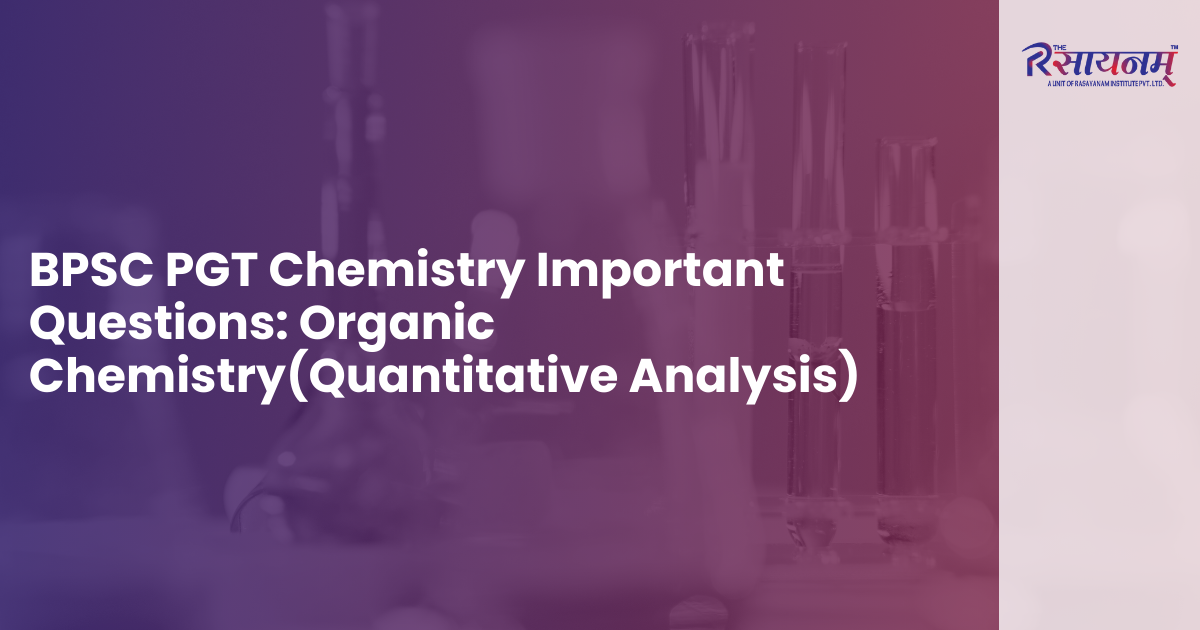 1. 0.350 g of an organic compound gave 100 ml of nitrogen collected at 250 K temperature and 700 mm pressure. Calculate the percentage composition of nitrogen in the compound. Use the Dumas method.
1. 0.350 g of an organic compound gave 100 ml of nitrogen collected at 250 K temperature and 700 mm pressure. Calculate the percentage composition of nitrogen in the compound. Use the Dumas method.
a) 25.70%
b) 35%
c) 35.71%
d) 36.88%
Answer: c
Explanation: Here, p = 700 mm; v = 100 ml; t =250 K
Volume of nitrogen at STP = p * v * 273/ 760 * t
= 700 * 100 * 273/ 760 * 250
= 100.57 ml
22,400 ml of nitrogen at STP weighs = 28 g
Then, 100.57 ml of nitrogen weighs = 28 * 100.57/22400
= 0.125 g
Therefore, percentage of nitrogen = 0.125 * 100/0.350
= 35.71%
So, the percentage of nitrogen in the organic compound is 35.71%.
2. Dumas’ method is a method of estimation of nitrogen.
a) True
b) False
Answer: a
Explanation: In quantitative analysis of nitrogen, one method is the Dumas method. In this process, the nitrogen-containing organic compound is heated with copper oxide in a carbon dioxide atmosphere, producing free nitrogen along with carbon dioxide and water.
3. The amounts of water can be detected by the increase in the mass of __________ during quantitative analysis of hydrogen.
a) potassium hydroxide
b) sodium hydroxide
c) sodium chloride
d) calcium chloride
Answer: d
Explanation: In quantitative analysis of hydrogen, the hydrogen in the compound is oxidized to water. The water formed is passed through a U-tube containing calcium chloride, which absorbs it and shows an increase in mass. This gain in mass corresponds to the amount of water, and thus the hydrogen, present in the organic compound.
4. On complete combustion, 0.500 g of an organic compound gave 0.150 of carbon dioxide. Determine the percentage composition of carbon in the compound.
a) 8.18%
b) 81.8%
c) 0.81%
d) 81%
Answer: a
Explanation: The required equation is:
Percentage of carbon = 12 * m2 * 100/ 44 * m
In this case, m = 0.500
m2 = 0.150
Substituting in the equation → Percentage of carbon = 12 * 0.150 * 100/ 44 * 0.500
= 8.18%
Therefore, the percentage of carbon present in the organic compound is 8.18%.
5. Carbon and hydrogen are detected by heating the compound with ____________ during quantitative analysis.
a) carbon dioxide
b) copper (II) oxide
c) magnesium oxide
d) sulphur dioxide
Answer: b
Explanation: In quantitative analysis, a measured amount of the organic compound is burned with excess oxygen and copper(II) oxide. The carbon is oxidized to carbon dioxide, while the hydrogen is converted into water.
6. In Kjedahl’s method of estimation of nitrogen, the compound containing nitrogen is heated with __________
Answer: b
Explanation: In this method, the nitrogen-containing compound is first heated with concentrated sulphuric acid, converting nitrogen into ammonium sulphate. On further heating with excess sodium hydroxide, ammonia gas is released, which is absorbed in a known amount of standard sulphuric acid. The amount of ammonia formed is then determined by measuring the sulphuric acid consumed.
7. Using the Carius method, find out the percentage of bromine in the compound if 0.450 g of organic compound gave 0.200 g of AgBr. (Given: molar mass of Ag = 108; molar mass of Br = 80)
a) 18%
b) 17%
c) 17.68%
d) 18.91%
Answer: d
Explanation: The molar mass of AgBr = 108 + 80
= 188 g
So, 188 g of AgBr contains 80 g of Br.
Then, 0.200 g of AgBr contains 80 * 0.200/ 188 = 0.085 g bromine
Therefore, percentage of bromine = 0.085 * 100/ 0.450
= 18.91%
Thus, the percentage of bromine (halogen) using Carius method is 18.91%.
8. In the estimation of sulphur, the organic compound is heated with ___________ in a carius tube.
a) sodium hydroxide
b) sodium peroxide
c) potassium hydroxide
d) calcium chloride
Answer: b
Explanation: For sulphur estimation, the organic compound is heated with sodium peroxide, which oxidizes sulphur to sulphuric acid. On adding excess barium chloride solution, sulphuric acid is precipitated as barium sulphate. The percentage of sulphur is then calculated from the mass of barium sulphate formed.
9. Estimation of oxygen can be determined by the Carius method.
a) True
b) False
Answer: b
Explanation: The Carius method is applied for estimating halogens in an organic compound. The percentage of oxygen is calculated either by subtracting the total percentage of other elements from 100 or by determining it from the amount of iodine formed.
10. The elements present in a compound are determined by apparatus called ____________
a) analyzer
b) CHN elemental analyzer
c) chemical analyzer
d) elemental analyzer
Answer: b
Explanation: Carbon, hydrogen, and nitrogen in an organic compound are estimated using a CHN elemental analyzer. This instrument needs only a tiny sample (1–3 mg) and quickly displays the results on a screen.
Related Question Bank to Read:
BPSC PGT Chemistry: p-Block Elements Important Questions
BPSC PGT Chemistry Important Question: Uses of Boron and Aluminium and their Compounds
BPSC PGT Chemistry: Trends and Anomalous Properties of Boron Important Questions
BPSC PGT Chemistry: p-Block Elements Important Questions
Silicon & P-Block Elements: Understanding Their Properties and Applications
Boric Acid & P-Block Element: Understanding Their Properties and Applications
BPSC PGT Chemistry: Important Compounds of Boron
 Download The Rasayanam App
Download The Rasayanam App

Also, download our brochure for more details on the program and contact us with any queries.
Conclusion
If you’re preparing for BPSC PGT Chemistry, then The Rasayanam provides structured courses, expert mentorship, and top-quality study resources to help you excel.


